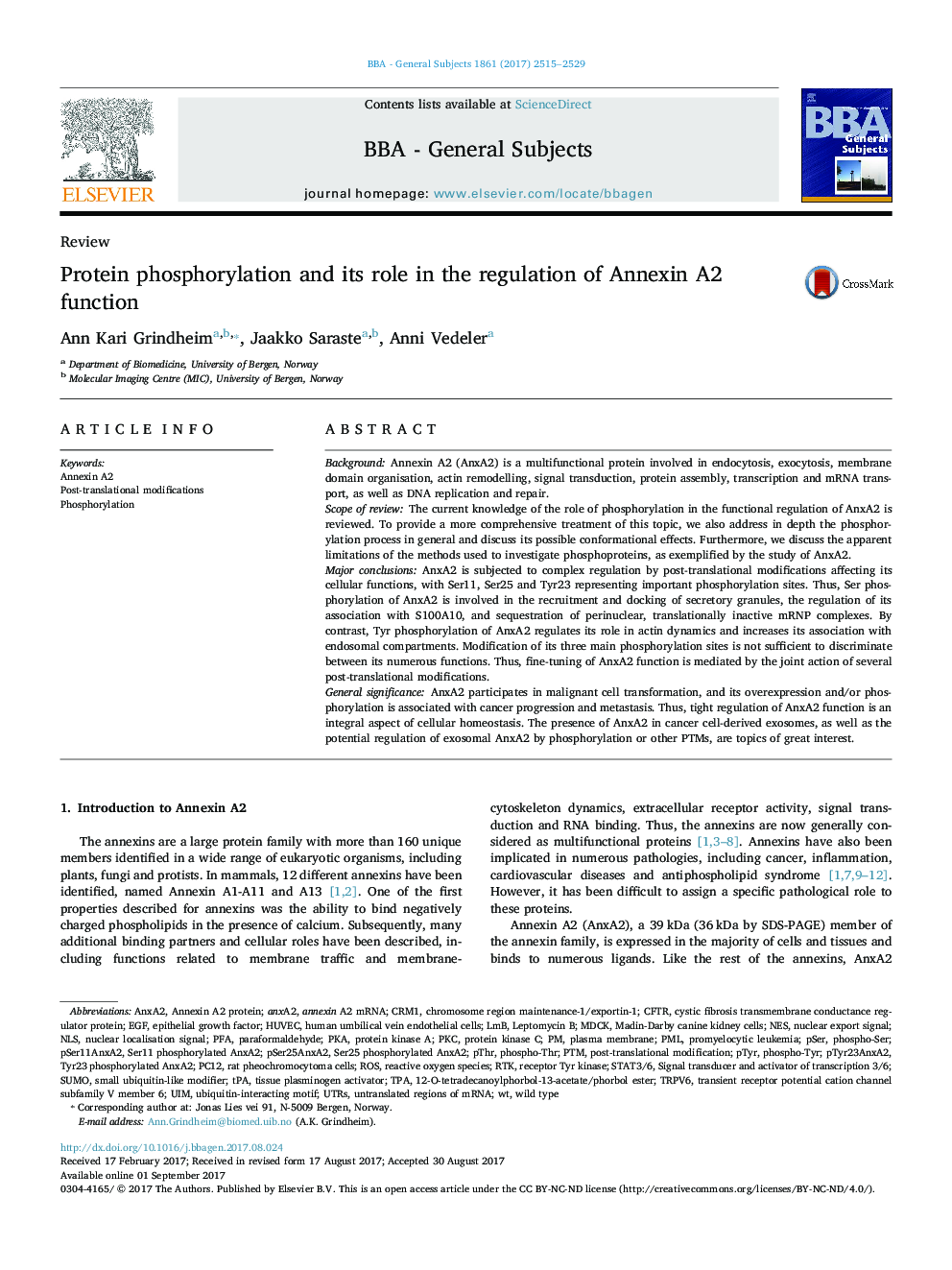| کد مقاله | کد نشریه | سال انتشار | مقاله انگلیسی | نسخه تمام متن |
|---|---|---|---|---|
| 5507841 | 1537481 | 2017 | 15 صفحه PDF | دانلود رایگان |

- The many functions of Annexin A2 are regulated by a variety of post-translational modifications
- A general discussion on the molecular and structural implications of phosphorylation is included
- Ser11, Ser25 and Tyr23 are the major phosphorylation sites in Annexin A2
- pSer25 Annexin A2 associates with secretory granules and translationally silent mRNAs
- pTyr23 Annexin A2 is linked to actin dynamics, the endosomal pathway and cancer progression
BackgroundAnnexin A2 (AnxA2) is a multifunctional protein involved in endocytosis, exocytosis, membrane domain organisation, actin remodelling, signal transduction, protein assembly, transcription and mRNA transport, as well as DNA replication and repair.Scope of reviewThe current knowledge of the role of phosphorylation in the functional regulation of AnxA2 is reviewed. To provide a more comprehensive treatment of this topic, we also address in depth the phosphorylation process in general and discuss its possible conformational effects. Furthermore, we discuss the apparent limitations of the methods used to investigate phosphoproteins, as exemplified by the study of AnxA2.Major conclusionsAnxA2 is subjected to complex regulation by post-translational modifications affecting its cellular functions, with Ser11, Ser25 and Tyr23 representing important phosphorylation sites. Thus, Ser phosphorylation of AnxA2 is involved in the recruitment and docking of secretory granules, the regulation of its association with S100A10, and sequestration of perinuclear, translationally inactive mRNP complexes. By contrast, Tyr phosphorylation of AnxA2 regulates its role in actin dynamics and increases its association with endosomal compartments. Modification of its three main phosphorylation sites is not sufficient to discriminate between its numerous functions. Thus, fine-tuning of AnxA2 function is mediated by the joint action of several post-translational modifications.General significanceAnxA2 participates in malignant cell transformation, and its overexpression and/or phosphorylation is associated with cancer progression and metastasis. Thus, tight regulation of AnxA2 function is an integral aspect of cellular homeostasis. The presence of AnxA2 in cancer cell-derived exosomes, as well as the potential regulation of exosomal AnxA2 by phosphorylation or other PTMs, are topics of great interest.
Schematic representation of the cellular roles of Tyr23 (pY) and Ser25 (pS) phosphorylated Annexin A2. Tyr23 phosphorylated Annexin A2 is linked to cortical actin dynamics, the endosomal pathway including endosomes, multivesicular bodies and exosomes. Oxidative stress causes nuclear Tyr23 phosphorylated Annexin A2 in PML bodies to undergo rapid and transient dephosphorylation and associate with SC-35-positive nuclear speckles. Simultaneously, cortical Annexin A2 becomes transiently Tyr23 phosphorylated, associates first with actin, then successively with early endosomes and multivesicular bodies (MVBs) and finally enters the lumen of exosomes. For clarity, the exosomes in the lumen of MVBs which contain Tyr23 phosphorylated AnxA2 and are secreted from the cell, are depicted as large structures. Ubiquitinated AnxA2 has also been detected in exosomes (not shown). Tyr23 phosphorylation, as well as binding to S100A10, is also required for the localisation of AnxA2 to the extracellular cell surface. The role of S100A10 in endosome binding of AnxA2 remains unresolved, as the complex has been found to associate with early/recycling endosomes, while AnxA2 monomer seems to associate with both early and late endosomes. Binding to S100A10 has been suggested to sequester AnxA2 in the cytoplasm. The AnxA2-S100A10 complex has not yet been detected in the nucleus, although there are reports on the nuclear localisation of S100A10. AnxA2 in the nucleus exists both in the non-phosphorylated and the Tyr23 phosphorylated form, showing differential association with different nuclear domains. Ser25 phosphorylated Annexin A2 associates with secretory granules and perinuclear non-polysomal, translationally silent mRNAs in mRNP complexes. It is absent from the nucleus and found as high-molecular-mass forms resulting from its conjugation to ubiquitin (Ub) and/or SUMO (Su), apparently triggered by the Ser25 phosphorylation of the protein. By contrast, non-phosphorylated Annexin A2 associates with polysomes attached to the cytoskeleton and/or S100A10 (not shown).219
Journal: Biochimica et Biophysica Acta (BBA) - General Subjects - Volume 1861, Issue 11, Part A, November 2017, Pages 2515-2529